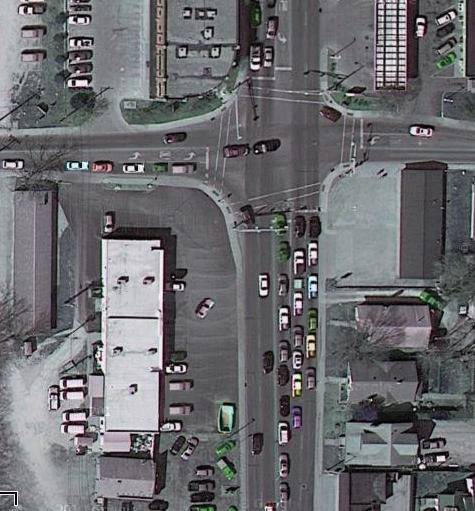 DESCRIPTION
DESCRIPTION DESCRIPTION
DESCRIPTION
THE PROBLEMS
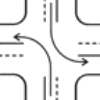 Because the quad lead signal sequence lets the left turns go before the straight-ahead traffic goes,
the left-turn and straight-ahead vehicles block each other in the left northbound straight-ahead lane.
The signal sequence (with some phases skipped on alternate cycles) is shown to the right.
Because the quad lead signal sequence lets the left turns go before the straight-ahead traffic goes,
the left-turn and straight-ahead vehicles block each other in the left northbound straight-ahead lane.
The signal sequence (with some phases skipped on alternate cycles) is shown to the right.ANALYSIS
Examining the Phase Sequence:
| Phase Axy: Northbound and southbound left.
This phase lasts only as long as both left turn lanes are full. May be skipped. |

|
Cars trying to make these turns can be blocked by other cars waiting for the signal. | |
| Phase Ax1: Northbound straight, left, and right.
This phase services the two movements that lock together. But it does not last long enough to help the backed up vehicles. |

|

|
Phase Ay2: Southbound straight, left, and right.
This phase appears only if no traffic is waiting to turn left in the northbound leg. |
| Phase A12: Northbound and southbound thru and pedestrian.
This phase (the coordinated phase) services major movements and associated crosswalks. Left and right turns are permissive. |

|
Cars trying to make these movements can be blocked by other cars waiting to turn. | |
| Phase Bxy: Eastbound and Westbound left.
This phase lasts only as long as both left turn lanes are full. May be skipped. |

|
Cars trying to make these turns can be blocked by other cars waiting for the signal. | |
| Phase Bx1: Eastbound straight, left, and right.
Services the high volume right turn and two movements that lock together. Does not last long enough to help backed up vehicles. |

|

|
Phase By2: Westbound straight, left, and right.
This phase can be skipped if not called. This phase appears only if no traffic is waiting to turn left in the northbound leg. |
| Phase B12: Eastbound and westbound thru and pedestrian.
This non-actuated phase services east-west movements and associated crosswalks Left and right turns are permissive. |

|
Cars trying to make these turns can be blocked by other cars waiting to turn. | |
The Effects on the Movements:
|
Phases Ax1, A12, and B12 are long. Phases Axy and Ay2 are short. Phases Bxy, Bx1, and By2 are short. Partial scores at left are in parentheses. |
||||||||||||||||||||||||||||||||||||||||||||||||||||||||||||||||||||||||||||||||||||||||||||||||||||||||||||||||||||||||||||||||||||||||||||||||||||||||||||||||||||||||||||||||||||||||||||||||||||||||||||||||||||||||||
The Benefits:
The Problems
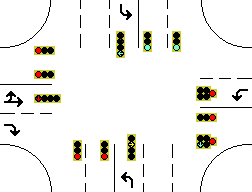 DESCRIPTION
DESCRIPTION
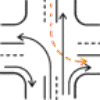 The traffic signal sequence is changed to a split-lead-lag sequence for both streets. This sequence is
shown in a fast animation to the right, and in a much slower animation showing the signal displays to the
above right. Neither diagram shows any phase skips, though all four left turns can be skipped.
The traffic signal sequence is changed to a split-lead-lag sequence for both streets. This sequence is
shown in a fast animation to the right, and in a much slower animation showing the signal displays to the
above right. Neither diagram shows any phase skips, though all four left turns can be skipped.ANALYSIS
Examining the Phase Sequence:
| Phase 1: Northbound straight, left, and right, with permissive southbound left.
This phase can be held as long as needed to alleviate the backed up northbound left turns and westbound right turns. Since the northbound movements occur at the same time, the left turning cars do not block vehicles intending to make other movements. |

|
| Phase 2: Northbound and southbound thru and pedestrian, with permissive left and right.
This phase services the major northbound and southbound movements and the associated pedestrian movements. Left and right turns are permissive, yielding to oncoming traffic and pedestrians. This is the coordinated phase. |

|
| Phase 3: Southbound straight, left, and right, with permissive northbound left.
This phase services any left turning cars unable to turn during phase 2. It may be skipped if it is not needed. This is a lagging left turn phase, but yellow trap is prevented by the flashing yellow arrow display for northbound left turns. |

|
| Phase 4: Westbound straight, left, and right.
This phase can be skipped if not called. It services waiting westbound left turns. Because eastbound left turns are in a shared lane, no permissive eastbound left turns are allowed. Because all westbound movements move at the same time during this phase, cars do not block each other. |

|
| Phase 5: Eastbound and westbound thru and pedestrian, with permissive left and right.
This phase services the major eastbound and westbound movements and the associated pedestrian movements. Left and right turns are permissive, yielding to oncoming traffic and pedestrians. This is a non-actuated phase. |

|
| Phase 6: Eastbound straight, left, and right, with permissive westbound left.
This phase services any left turning cars unable to turn during phase 5. It may be skipped if it is not needed. It services the high volume eastbound right turn. This is a lagging left turn phase, but yellow trap is prevented by the flashing yellow arrow display for northbound left turns. |

|
The Effects on the Movements:
|
Phases 1, 2, and 5 are long. Phases 3, 4, and 6 are short. Partial scores at left are in parentheses. |
||||||||||||||||||||||||||||||||||||||||||||||||||||||||||||||||||||||||||||||||||||||||||||||||||||||||||||||||||||||||||||||||||||||||||||||||||||||||||||||||||||||||||||||||||||||||||||||||||||||||||||||||||||||||||
The Benefits:
The Problems
RESULTS
The scores are simple attempts to calculate the traffic handling abilities of the movements.
| Traffic Movement | Old Design | New Design |
|---|---|---|
| Major Movements Score | 39 | 46 |
| Minor Movements Score | 62 | 54 |
| Vehicle Movements Score | 101 | 100 |
| Pedestrians Score | 34 | 34 |
| Total Score | 135 | 134 |
Notice that the major movement score is much higher with the new design.
Since this has not actually been implemented, traffic counts would not make any sense.

BEFORE |
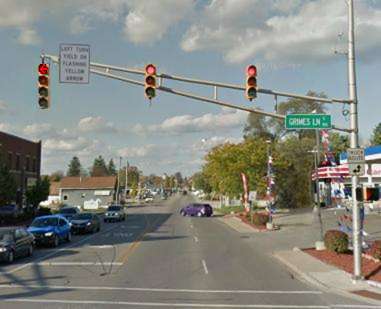
AFTER
|